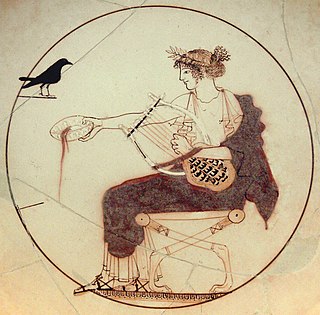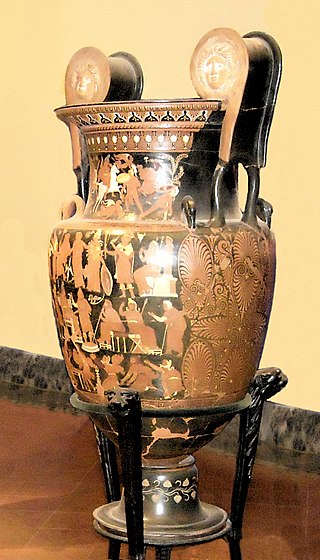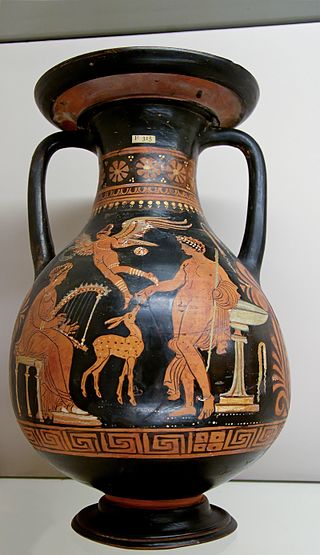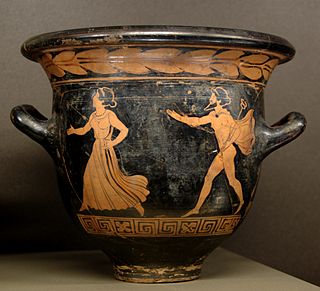
Black-figure pottery painting is one of the styles of painting on antique Greek vases. It was especially common between the 7th and 5th centuries BCE, although there are specimens dating in the 2nd century BCE. Stylistically it can be distinguished from the preceding orientalizing period and the subsequent red-figure pottery style.

Red-figure pottery is a style of ancient Greek pottery in which the background of the pottery is painted black while the figures and details are left in the natural red or orange color of the clay.

Euphronios was an ancient Greek vase painter and potter, active in Athens in the late 6th and early 5th centuries BC. As part of the so-called "Pioneer Group,", Euphronios was one of the most important artists of the red-figure technique. His works place him at the transition from Late Archaic to Early Classical art, and he is one of the first known artists in history to have signed his work.

White-ground technique is a style of white ancient Greek pottery and the painting in which figures appear on a white background. It developed in the region of Attica, dated to about 500 BC. It was especially associated with vases made for ritual and funerary use, if only because the painted surface was more fragile than in the other main techniques of black-figure and red-figure vase painting. Nevertheless, a wide range of subjects are depicted.

The Providence Painter is the conventional name given to a painter of the Attic red-figure style. He was active around 470 BC.

The Sisyphus Painter was an Apulian red-figure vase painter. His works are dated to the last two decades of the fifth century and the very early fourth century BC.

The Foundry Painter was an ancient Greek Attic red-figure vase painter of the Late Archaic period. His real name is unknown; the conventional name is derived from his most famous work, the Berlin Foundry Cup.

The Ilioupersis Painter was an Apulian vase painter. His works are dated to the second quarter of the 4th century BC.

The Darius Painter was an Apulian vase painter and the most eminent representative at the end of the "Ornate Style" in South Italian red-figure vase painting in Magna Graecia. His works were produced between 340 and 320 BC.

The Tarporley Painter was a Greek Apulian red-figure vase painter. His works date to the first quarter of the 4th century BC. The Tarporley Painter is his period's most important representative of the so-called "Plain Style". He is considered to have been the pupil and successor of the Sisyphus Painter, as indicated by his elegant fine-limbed figures and the solemn facial expressions of his woman and cloaked youths. He painted garments in a less balanced style then the Sisyphus Painter. His heads are often oval and lean forwards. The spaces between his figures are often filled with flowers, branches or vines. Over time, his drawing style becomes more fluid, but also less precise. He painted especially on bell kraters, on which he often depicted dionysiac themes and theatrical scenes. His work includes the first known phlyax vase, showing the punishment of a thief, accompanied by a metric verse inscription. Mythological scenes by him are rare. There appears to be an especially close relationship between the work of the Tarporley Painter and that of the Dolon Painter, perhaps they cooperated directly for some time. His succession is represented by three separate schools, each clearly influenced by him. The most important painter of the first is the Schiller Painter, of the second the Hoppin Painter and of the third the Painter of Karlsruhe B9 and the Dijon Painter.

The Varrese Painter was an Apulian red-figure vase painter. His works are dated to the middle of the 4th century BC.

Apulian vase painting was a regional style of South Italian vase painting from ancient Apulia in southeast Italy. It comprises geometric pottery and red-figure pottery.

The Pisticci Painter was a vase painter who lived in the second half of the 5th century BC. Many of his artistic works were discovered in Pisticci, a small town a few kilometers from Metaponto, Lucania, Italy.

Gnathia vases are a type of pottery belonging to ancient Apulian vase painting of the 4th century BC.

Campanian vase painting is one of the five regional styles of South Italian red-figure vase painting fabricated in Magna Graecia. It forms a close stylistic community with Apulian vase painting.

Lucanian vase painting was substyle of South Italian red-figure vase painting fabricated in Magna Graecia, produced in Lucania between 450 and 325 BC. It was the oldest South Italian regional style. Together with Sicilian and Paestan vase painting, it formed a close stylistic community.

Paestan vase painting was a style of vase painting associated with Paestum, a Campanian city in Italy founded by Greek colonists of Magna Graecia. Paestan vase painting is one of five regional styles of South Italian red-figure vase painting.

The Underworld Painter was an ancient Greek Apulian vase painter whose works date to the second half of the 4th century BC.

The Painter of the Berlin Dancing Girl was an Apulian red-figure vase painter, who was active between 430–410 BC. He was named after a calyx krater in the collection of the Antikensammlung Berlin, which depicts a girl dancing to the aulos played by a seated woman.

The find complex associated with a group of ancient Apulian picture vases for a funeral ceremony consists of 29 vases, plates, vase fragments, and fragment groups, which are showpieces of the Berlin Collection of Classical Antiquities in the Altes Museum. The vase ensemble comprises vases of varying sizes and values, consistently decorated with images in the rich style of Apulian vase painting. Additionally, there are vases of medium and low quality. All the pieces likely originate from a looted excavation in the latter half of the 20th century.





















